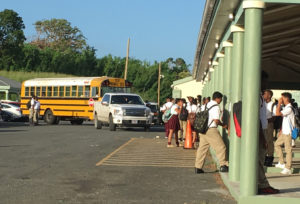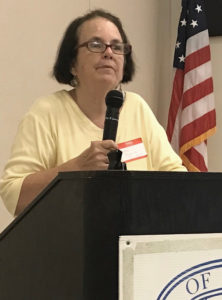
The annual observance of Black History Week was reestablished and strengthened with the move of Christiansted High School to the newly constructed campus of St. Croix Central High School in 1967. With the Christiansted students and some from Claude O. Markoe School, Frederiksted, and one half of the faculty, the only public high school on St Croix, with approximately 900 students, had relocated to a rural Kingshill.
At Christiansted High, the observances of Black History Week were rooted in the social studies classroom and were the focus for teacher-directed activities. At the Kingshill campus, were ten long-row buildings, one for each subject area. The 1000 wing was for the social studies department, under the direction of Chair Mark Milligan. Milligan had just returned from an extended tour of Africa and displayed African history daily by wearing elaborate tribal robes. At the new location, there was ample space for expanded schoolwide participation in classrooms, cafetorium, library and the courtyard.
According to Regina Williams, the social studies department chair, the second half of the faculty, formed at Central were Crucian graduates returning home followed by their fellow roommates and classmates mainly from the Historically Black Colleges and Universities. African American graduates seeking teaching positions were recruited by the Superintendent of Education Gloria Canegata, herself a graduate of Hampton.
As per tradition, the cornerstone of the Black History observance was the student reports on Carter G. Woodson, noting his initiation in 1926 of a dedicated period of study of the Black experience. Then there were recognitions of “the firsts,” the first Black inventor, the first agriculturalist with peanuts, the first Black judge of the Supreme Court and others. Added to the African American “firsts” was the Virgin Islands’ last appointed and first elected governor, Melvin H. Evans and the first Hispanic governor, Juan Francisco Luis, both of whom were invitees.
Crucian educators such as Eulalie Rivera, Delta Dorsch and Ruth Beagles were invited to relate their experiences in teaching at the island’s public schools, called “country” or “von Scholten” schools. These one-room schoolhouses were created in 1849 for the education of enslaved children and were in use up until the 1950s. Dorsch usually ended her presentation with a ‘Broo Nanci story.
Besides relaying the history of the past, students listened to the inspirational poems of kindergarten teacher, Winnie “Oyoko” Loving, Marlon Williams and student dramatic readings of national poets such as Maya Angelou and Rita Dove. Hit songs of the time made popular by artists such as Roberta Flack, Aretha Franklin and Donna Summer. These were interpreted by talented student singers. Before courses in modern dance became part of the curriculum, students performed interpretive renditions. Jimmy Hamilton, noted clarinetist and saxophonist for the late Duke Ellington’s band, as music teacher led students in jazz musicals.
In 1970, students were also influenced by Mario Moorhead, who taught social studies, notes Williams. After his experiences in Washington, D.C., he had formed the United Caribbean Association (UCA), which offered cultural programs in its Frederiksted building. His mesmerizing lectures informed teachers and students of the principles of knowing one’s history and identity. The importance of highlighting vignettes of everyday Crucian culture was rendered through dramatic skits in which students wrote and performed market women’s dialogs.
During Black History observations, which in 1976 had been extended for the entire month of February, the newly recruited teachers relayed their experiences which they had lived through as African Americans. They described the lunch counter sit-ins at Greensboro, NC, as well as in other southern cities. They described the police responses to their protests when their cities, Detroit, Newark, Chicago, Birmingham, Montgomery and others were embroiled in civil rights marches. They felt the indignity of being oppressed by police with their batons, the high-pressured fire hoses and the menacing dogs. Both in the classrooms and informally in the teacher’s lounges, these newcomers described their participation in the movement. Their retelling of the events enlightened Crucian students and teachers and recruits from northern states, especially Caucasian educators.
As students, these African American teachers remembered the blocking of African American James Meredith from enrolling at the University of Mississippi by Governor Ross Barnett, as well as the divisiveness of the community that two students hoping to be freshmen at the University of Louisiana had experienced. The students relayed details of the times that they personally had to sit at the back of the bus, drink from a “colored only” water fountain or travel by car from a northern to a southern state.
These newly recruited teachers to the Virgin Islands, who were students at HBCUs during these upending times, participated in pressuring authorities for change. Stories were told of the bus rides of the Freedom Riders to demonstrate the segregation of the interstate bus lines, and the registering people to vote after poll taxes and literacy tests were lifted in the Voting Rights Act of 1965.
They described how they had marched on their campuses, took over their college’s administrative offices, of both HBCU and ivy league schools, such as Brandeis and Cornell, demanding that courses in African American studies be instituted. A daughter of migrant Virgin Island parents, Gloria Joseph, played an instrumental role in the demonstrations at Cornell. In later years, she implored St. Croix teachers taking her courses in education at UVI to recognize racism around them.
In response to the action being taken by students and other Black Americans against the many injustices, positive actions were initiated. In 1964 the U.S. Congress passed the Civil Rights Act. President Lyndon Johnson, who had given the commencement address at Howard, had signed the Fair Housing Act, which outlawed discrimination in the sale or rental of houses. The renowned physicist, Albert Einstein, related his encounters with race relations in America and his subsequent membership and active involvement in national organizations against prejudice to graduates at Lincoln University. He compared his experiences with the discrimination he had experienced as a Jew in Nazi Germany to those of the African Americans in the U.S.
As the 1960s ended, the start of hard-won protections for African Americans was achieved. Among them were the Supreme Court’s ruling mandating desegregation of all public schools, the outlawing of red-lining systems in neighborhoods, the extension of the voting rights and the mandating of racial integration in public schools.
Along with the politics, there were definitive changes that brought out the identity of a people. Fashion made a statement. The afro was the hairstyle of the times, and more teachers wore the dashiki-style shirts and long dresses sewn from African print cloth. A highlight of the calendar was the annual Ebony Fashion Show as a fundraising event at Island Center in January.
In the 54 years that Central High School has been in existence, the merging of the Crucian cultural experience with the history of the hard-won civil rights gained during the early years was recognized through the guidance of stateside teachers and the student responses through readings and performances. Many CHS graduates continued to enroll in HBCUs, which were supported financially by the president’s office. President Trump instituted a 10-year allocation. With the inauguration of Kamala Harris, a graduate of Howard and now the vice president of the country, there will undoubtedly be a continued focus on African American education and societal values.

Recently, for the second year, four Virgin Islands students were invited to visit virtually Virginia State University to be oriented to the college experience. The program emphasizes writing and speaking skills and entrepreneurship with the direction of mentors.
Not to be missed in this year of virtual programming, the Association for the Study of African American Life and History has announced the theme for 2021: “The Black Family: Representation, Identity and Diversity.” A listing of their numerous virtual activities scheduled throughout the month can be found at their website, www.asalh.org.
During this time, the Association for the Study of African American Life and History encourages everyone to resolve to learn something new during Black History Month.





